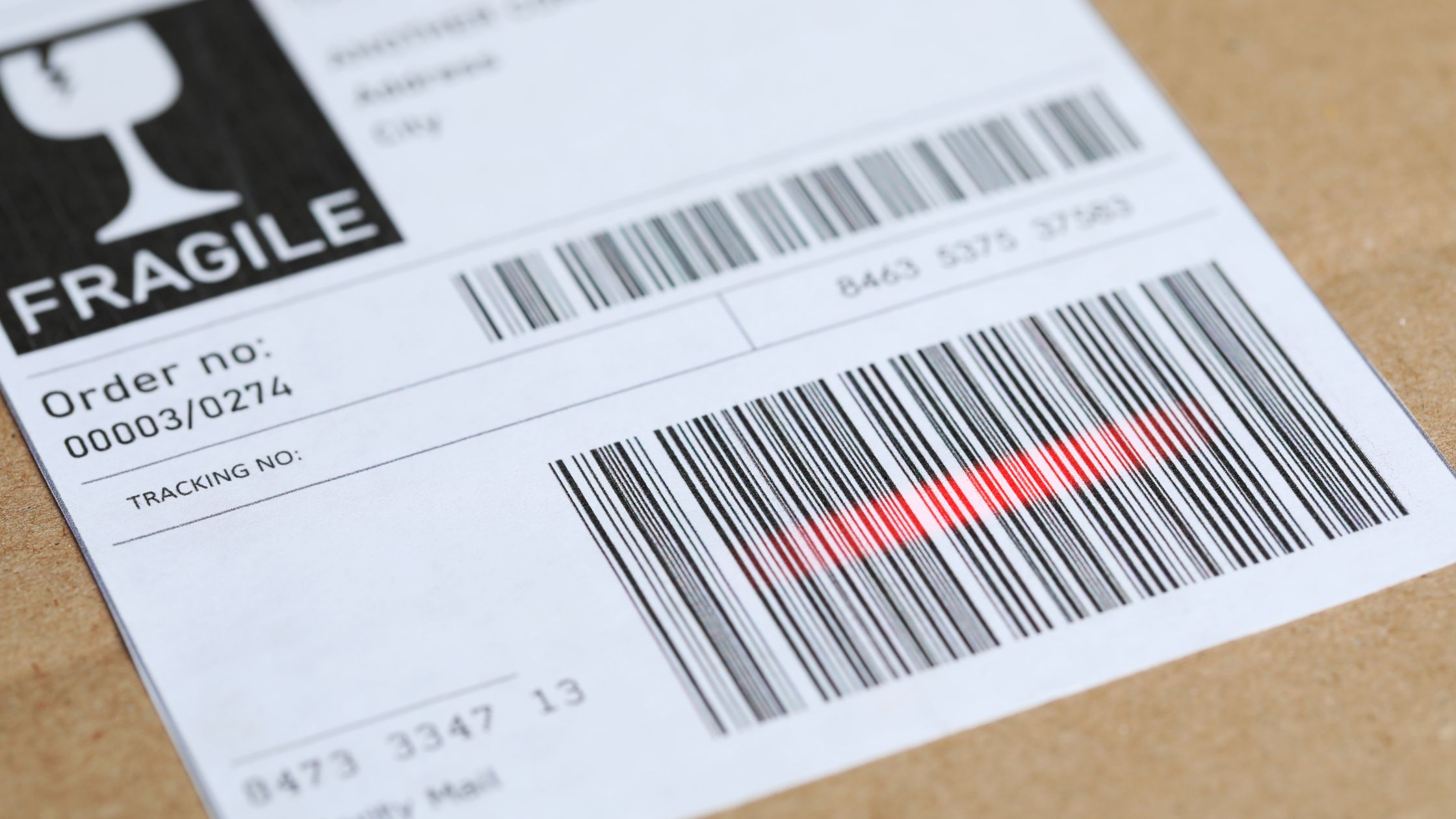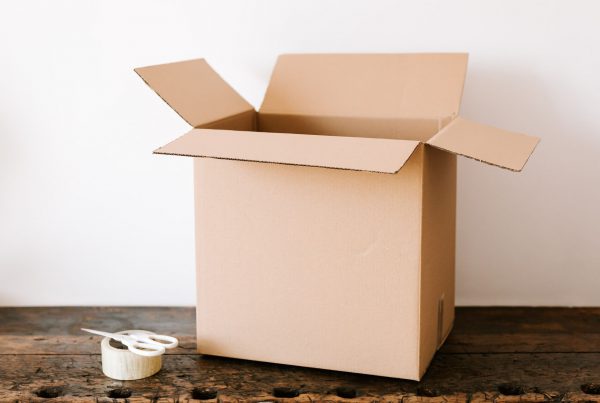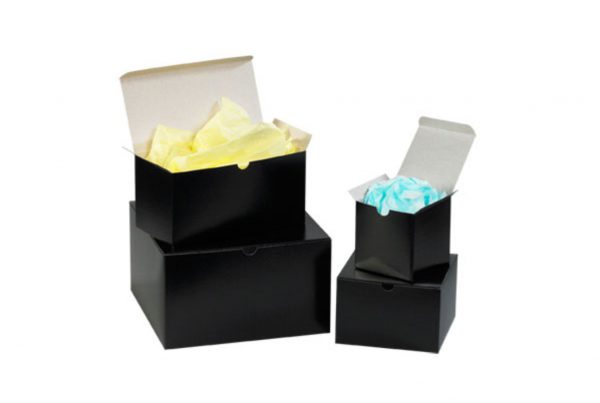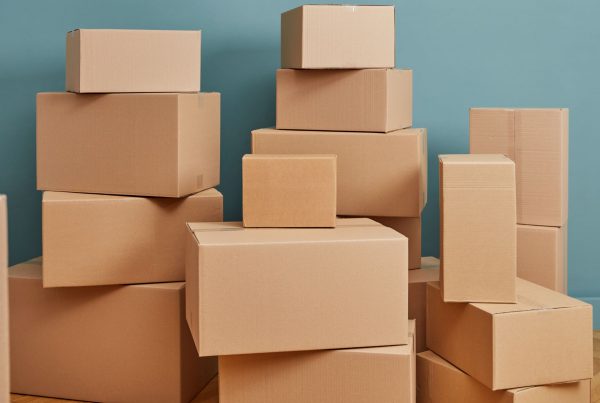Surprising fact: companies that turn labels into clear brand touchpoints cut misroutes and customer questions by up to 30%—and you can do the same with a few smart choices.
At The Boxery, we guide you through branding-led labeling so you make confident choices that impress customers and simplify operations.
We match label size and placement to real corrugate specs—from 32 ECT standards like 8″ x 6″ x 4″ to heavier 200# Mullen cartons—so your barcode scans fast and your brand looks sharp.
Think of every carton as a tiny billboard: resilient adhesives, abrasion-resistant zones, and the right panel choice keep information visible through moving and carrier networks.
Result: consistent brand impressions and fewer sortation exceptions—meaning on-time arrivals and fewer “where is my package?” tickets for your customers. If you need to order shipping boxes right now, that’s easy, too.
Key Takeaways
- Smart labels turn routine deliveries into memorable unboxing moments.
- The Boxery’s carrier-certified sizes help you pick the right panel for visibility.
- Match label sizing and adhesive to corrugate ratings like 32 ECT or 200# Mullen.
- Place labels where adhesives grip and barcodes survive abrasion.
- Proper labeling reduces exceptions and improves customer satisfaction.
Turn every Shipping Box into a brand touchpoint with The Boxery
Make your arriving parcels feel like a welcome at the door with thoughtful labels and design. We help you turn utilitarian cartons into polished brand extensions with practical guidance, empathetic support, and pro results.
The Boxery stocks over 1,000 sizes and is certified for use with national carriers. That means your brand looks consistent across small mailers, retail packs, and heavy-duty options. For a clean, simple look on any mailing box, keep the shipping label clear of seams and straps.
Use a primary branded label and a clean shipping label on the largest flat panel to maintain logo visibility and wayfinding clarity.
Create color bands, icons, and QR codes that link to quick-start guides or customer service to boost post-delivery engagement.
Choose recycled and FSC- or SFI-certified materials when sustainability matters to your customers.
Keep fonts generous, contrast high, and whitespace deliberate. These small choices help handlers and customers find the right parcel fast and improve the home or store receiving experience.
Quick comparison
| Category | When to use | Branding benefit |
| Standard Strength | Everyday retail and light goods | Consistent label placement across SKUs |
| Heavy Duty | Bulky or fragile items | Durable surfaces for long transit and clear scanning |
| Corrugated Mailers | Small shipments and subscriptions | High logo visibility with minimal material |
| Retail Boxes | In-store display and direct-to-consumer | Premium finish for unboxing moments |
Smart labeling hacks that work on real-world box specs and duties
Practical label choices make handling faster and keep your brand visible through real-world transit. Match label size to corrugate strength so adhesives and scanners both win.
Match label size and placement to ECT and Mullen ratings
Use smaller labels on 32 ECT panels; they flex and wrinkle more. Larger labels work well on 200 lb. and 275 lb. Mullen faces, including a double-wall for heavy-duty needs.
Use corner and seam zones for better adhesion
Place labels on the largest uninterrupted panel. Avoid deep seams and edge flutes where adhesives lose bite and scanners fail.
Color-code without hiding barcodes
Apply color accents for SKU families on white or kraft surfaces, but keep a quiet zone around barcodes. High-contrast, matte areas scan reliably.
Dual labels on telescoping cartons let handlers scan from any side. Add a clear packing slip pouch near the main label to speed receiving and returns.
Print handling icons on heavy-duty and wardrobe cartons to reduce damage. For deeper how-to guidance on labeling boxes, we’ve got you covered.
Choose the right box size and shape to elevate label visibility
A well-sized carton helps labels stay flat, legible, and instantly recognizable on the shelf or doorstep.
Cubes vs. flats vs. long rectangles: where labels land best
Cubes offer a generous front panel for primary labels and logos. That front face keeps barcodes and branding unobstructed.
Flats favor landscape labels that don’t wrap. They work well when you want a single, wide label to sit cleanly across the face.
Long rectangles often need side-panel placement so scanners hit the barcode at the right angle. For posters or rods, a telescoping tube keeps the label flat and protected. When you truly need a box large for long or odd gear, choose a long shipping style.
Small, medium, large, and extra-large: keep labels readable at a distance
Pick sizes that keep text legible from six to ten feet. Receiving teams and home recipients spot the right package faster when typography scales with carton volume.
Smaller cartons carry condensed info—ship-to, order number, and a compact brand mark. Large and extra-large cartons can include icons, care tips, and short handling notes. If you’re wondering where to buy small shipping boxes or where to buy big cardboard boxes, you’ve got options at hand.
Consistency: mirror label placement across SKUs so people and scanners know where to look.
Finish: white board for retail polish; kraft for natural warmth—both accept high-contrast labels when clean and dry.
Interruptions: avoid handles, seams, or straps on the chosen face to keep scans clean.
The Boxery helps you quickly size the proper carton so labels read cleanly from shelf to doorstep and handlers move with confidence.
Shipping Box types for branding, packing, and storage workflows
Different carton types serve different roles—presentation, protection, or compact storage—and the right pick speeds every workflow.
Standard strength, heavy-duty, and corrugated mailers: when each shines
Standard Strength is cost-efficient for lighter loads and inner cartons. Use 32 ECT for routine deliveries and storage where the weight is low. Heavy-duty (including 275 lb. test and double-wall) protects dense or fragile goods. Corrugated mailers shine for small goods and branded inserts—clean lid panels are perfect for sharp logos and return instructions. Need branded subscription looks? Consider clean, sturdy mailer boxes.
Retail boxes and custom-ready surfaces for premium presentation
White retail faces lift graphics; Kraft surfaces communicate natural values. Both host badges, like FSC and SF, help customers see your sustainability claims. For kits and tiny parts, classic tuck boxes keep everything tidy and presentable.
Eco-forward choices to print sustainability badges
We offer Recycled, FSC, SFI, and EPA CPG options for buyers who value certified materials in bulk or single runs.
Telescoping and multi-depth options when product dimensions vary
Telescoping and multi-depth styles let you size the carton to the product so labels sit flat—no awkward wraps or overhangs. This helps in storage and reduces pick errors.
“Define three hero types—mailer, standard RSC, and heavy duty—then templatize label placement so teams move fast without guesswork.”
Pick 32 ECT for light, general needs; step up to 200#–275# or 350# Mullen for heavy routes and stacking. Bulk purchasing lowers per-unit cost and keeps substrates consistent across orders.
Operational wins: carrier-ready specs, bulk pricing, and US delivery
Carrier-certified construction supports reliable scanning and routing
Reliable routing starts with carrier-certified substrates, pro-grade supplies, and a clear pick-pack-label routine. We outfit your operation so labels survive conveyors and scanners read the first time. Carrier-certified construction yields flatter faces and stronger edges. That means fewer label failures and faster sortation across national networks.
Wholesale quantities and tiered pricing for scale-ups
Buying in bulk standardizes surfaces and lowers per-unit cost. Consistent substrates improve adhesion, contrast, and print quality—so labels last from warehouse to door. If you’re comparing box wholesale rates, talk to the team—tiering helps.
Use quality packing tape, kraft paper, and bubble wrap for label integrity
Pick materials that protect panels: high-grade packing tape, kraft paper rolls, and bubble wrap cushion contents and keep faces flat.
Avoid running tape over barcodes; burnish label edges and keep panels clean and dry for best scans.
Pick, pack, and label sequence to cut misroutes in busy seasons
Adopt a simple rhythm: verify order, seal, label, then handheld-scan for quality. Add a secondary side label on long or telescoping cartons so hubs can read codes from any angle.
Toolkit tip: keep a squeegee, spare ribbons, and wipes at workstations. Measure: track failed scans by size and style to spot substrate or label-size fixes.
Shop The Boxery: boxes, supplies, and services that power your labeling strategy
Find the right mix of sizes, surfaces, and tools so your labels land perfectly—every time. We make it fast to browse certified options and pick practical combos for packing, branding, and scan success.
Explore 1,000+ sizes so your label fits the face area without wrapping or crowding barcodes. Use filters from extra-small to oversized and pick telescoping or multi-depth styles when dimensions vary.
Stock in bulk to unify substrates and finishes—labels print and adhere the same across SKUs. Looking for a true deal? Start with box cheap options that don’t compromise the build.
Add essential supplies: clear packing slip pouches, durable tapes, and thermal labels to lock in legibility and durability. Flexible on sizes? Our budget boxes list rotates with seasonal promos.
Choose Standard Strength, Heavy Duty, Corrugated Mailers, or Retail Boxes based on protection and presentation needs—then finish your cart by clicking through to box buy deals while they’re hot.
We’ll map a starter kit—three go-to sizes per speed plus a telescoping option—to keep operations simple and scalable. Planning a move and not sure where to buy box? We’ve got full moving supplies ready.
Plan for moving seasons with extra-large and wardrobe styles and bold icons to speed handling and reduce damage.
Filter for eco choices like Recycled, FSC, and SFI when you want sustainability badges near your mark.
Our team stays responsive on sizing, print surfaces, and label placement—lean on us for quick, informed answers that save time and reduce relabels.
Conclusion
Close the loop on your packing system with simple rules that make each delivery feel deliberate and reliable.
Pair smart label placement with the right box, and you cut friction across picking, packing, scanning, delivery, and the moment a customer opens it at home.
Keep a lean checklist—print, verify, apply, burnish, scan—and store your supplies within reach to protect label quality during busy moving weeks.
Step up to heavier-duty when payloads demand it, use eco-forward packaging with visible badges, and buy in bulk when it saves cost and time.
The Boxery’s mission is to help you ship with confidence—clear labeling, right-sized cartons, and caring guidance every step of the way so customers feel it in on-time arrivals and tidy unboxings.
FAQ
What label sizes work best for different ECT and Mullen ratings?
Match label size to the board strength and package face. For 32 ECT (standard corrugated,) a mid-size label (4″ x 6″) balances scannability and adhesion. For 200# and 275# heavy-duty boards, larger labels (6″ x 8″ or larger) provide better barcode quiet zones and help prevent curling on thick flutes. Always test on the actual substrate before full runs.
Where should I place labels on corrugated boxes for reliable scanning?
Use flat faces away from corners, seams, and flutes. Corner and seam zones often cause wrinkling or lift. Place labels in the center of the largest face or on a designated label panel. For telescoping or oversized styles, consider dual labels on opposite faces so any-side scanning works.
How can I color-code SKUs without obscuring barcodes?
Apply color blocks or edge bands that leave the barcode quiet zone intact. Use contrasting hues on the outer perimeter or a small corner panel. On white, kraft, or heavy-duty surfaces, test print contrast and barcode readability; high contrast between barcode and background ensures reliable scans.
When should I add a packing slip pouch or clear sleeve?
Use clear pouches on orders that require visible paperwork for receiving or returns. They protect invoices from moisture and make checks faster at the dock. For high-volume flows, attach pouches to the same face as the shipping label to keep documentation and labels together.
Which handling icons should I print on heavy-duty and wardrobe boxes?
Use standard handling symbols for fragile, this-side-up, do not stack, and weight warnings. Print them near the top edge and on multiple faces for visibility. These icons reduce mishandling and align carrier crews around correct lift and placement during transit.
How do box shape and size affect label visibility?
Cubes offer large, flat faces for central labels; flats and long rectangles may require narrower, elongated labels along the long axis for readability. Small sizes need compact, high-contrast labels; extra-large boxes benefit from oversized labels visible from a distance. Choose a label size that matches your workflow’s viewing distance.
Which box types are best for branding versus inexpensive parceling?
Retail-ready and custom-ready surfaces work best for premium presentation and brand printing. Standard strength and corrugated mailers are cost-effective for basic parceling. Heavy-duty, telescoping boxes provide protective features and sizing flexibility while still allowing prominent branding panels.
Are eco-friendly boxes suitable for printed sustainability badges?
Yes. Recycled, FSC, and SFI-certified boards take print well and communicate your sustainability credentials. Use simple, bold badge designs to maintain high contrast and avoid small details that won’t reproduce reliably on kraft textures.
How can I ensure carrier-certified specs for reliable scanning and routing?
Select boxes and labels that meet carrier guidelines for barcode placement, quiet zones, and adhesive strength. Carrier-certified construction typically uses consistent board caliper and flat faces that reduce read errors. Confirm with your carrier’s spec sheet before large runs.
What supplies help preserve label adhesion during transit?
Quality packing tape applied over label edges, kraft paper void fill, and bubble wrap protect contents and keep labels flat. Avoid taping directly over barcodes unless using clear, non-glare tape designed for scanners. Proper tape and filling prevent edge lift and water damage.
How does the sequencing of pick, pack, and label reduce misroutes?
Sequence work so labels are printed only after final pick-and-pack checks. Label at a dedicated station with controlled lighting and flat surfaces. This reduces overlabeling, mismatches, and double-handling during peak volume.
Do you recommend dual labels for oversized or telescoping boxes?
Yes. Dual labels on opposite faces allow any-side scanning and speed up sorting. For telescoping boxes, place a label on the outer sleeve and, if seams could obscure the main barcode during handling, on the inner panel.
Can I bulk-order boxes and get tiered pricing for high-volume shipping?
Absolutely. Wholesale quantities and tiered pricing are common for scale-ups. Buying in bulk reduces unit cost and ensures consistent stock for busy seasons — just confirm storage and duty terms to match your delivery cadence.
How do I choose a label adhesive for heavy-duty corrugated mailers?
Choose a high-tack adhesive designed for rough or fibrous surfaces. Cold-weather or low-tack adhesives can fail on coarse flutes. Test a small run under your expected storage and shipment conditions to validate adhesion and scanner readability.
What should I consider when adding branding to small parcels?
Use simple, bold logo placements and minimal text to preserve scannability. On small parcels, less is more — a memorable mark and high-contrast colors create impact without crowding the label area or interfering with carrier elements.
How can I streamline returns with labeling and packaging choices?
Pre-print return labels or include a QR code for easy label reprint. Use clear pouch placement and add simple return instructions on the packing slip. Durable materials and clear labeling reduce friction for customers and speed processing on receipt.





Recent Comments